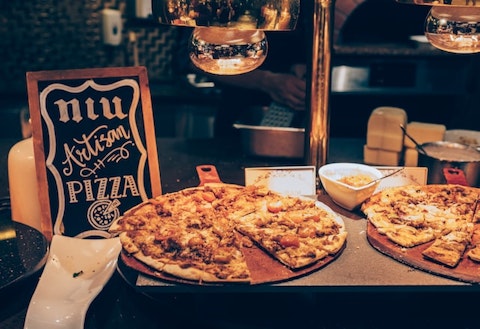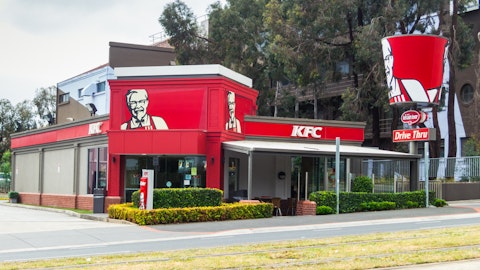Domino’s Pizza, Inc. (NYSE:DPZ) Q4 2022 Earnings Call Transcript February 23, 2023
Company Representatives: Russell Weiner – Chief Executive Officer Sandeep Reddy – Chief Financial Officer Ryan Goers – Vice President, Finance, Investor Relations
Operator: Thank you for standing by and welcome to Domino’s Pizza’s Fourth Quarter 2022 Earnings Conference Call. At this time all participants are in a listen-only mode. After the speakers’ presentation, there will be a question-and-answer session. . As a reminder, today’s program is being recorded. And now I’d like to introduce your host for today’s program, Mr. Ryan Goers, Vice President, Finance and Investor Relations. Please go ahead, sir.
Ryan Goers: Thank you and good morning. Thank you for joining us today for our conversation regarding the results for the fourth quarter and full year 2022. Today’s call will feature commentary from Chief Executive Officer, Russell Weiner; and Chief Financial Officer, Sandeep Reddy. As this call is primarily for our investor audience, I ask all members of the media and others to be in a listen-only mode. I want to remind everyone that the forward-looking statements in this morning’s earnings release and 10-K also applied to our comments on the call today. Both of those documents are available on our website. Actual results or trends could differ materially from our forecast. For more information, please refer to the risk factors discussed in our filings with the SEC.
In addition, please refer to the 8-K earnings release to find disclosures and reconciliations of non-GAAP financial measures that may be referenced on today’s call. I’ll request to our coverage analysts, we want to do our best this morning to accommodate as many of your questions as time permits. As such, we encourage you to ask only one one-part question on this call. Today’s conference call is being webcast and is also being recorded for replay via our website. With that, I’d like to turn the call over to our Chief Executive Officer, Russell Weiner.
Russell Weiner: Thank you, Ryan, and thanks to all of you for joining us this morning. As we end 2022 and look back to the beginning of the pandemic, I’m encouraged by the incredible work done by Domino’s team members and franchisees. Since the beginning of 2020, we and our franchisees have grown by 2,860 new stores around the world, when many restaurant brands closed stores or struggled to grow through an extremely difficult time for store development. Domino’s is in over 90 markets and should hit 20,000 as a system in 2023. In the U.S. the QSR pizza category grew over the last three years with sales up almost 10% versus pre-pandemic levels. Domino’s serviced that growth resulting in a gain of approximately three share points in the QSR pizza category since 2019 according to NPD.
We continue to grow our Carryout business. Carryout now comprises approximately half of the orders and about 40% of sales in the U.S. Carryout remains highly incremental to delivery for us, and in cases where it’s not incremental, customers are moving to a service method with significant lower costs for our system. Our delivery business experienced both headwinds and tailwinds over the past three years. Our team focused efforts on finding solutions at every turn. Now to the fourth quarter. In the fourth quarter, our results were mixed, particularly with the challenges in the U.S. delivery business that we previewed during our Q3 call. During that call, I pointed to a couple of dynamics we were watching in the broader restaurant category that have since played out.
First, as consumers returned to many of their pre-COVID eating habits, some of the sit-down business that was a source of volume for restaurant delivery orders returned to that channel. Second, inflation impacted delivery due to the added expenses of fees and tips in that channel. Our research shows that a relatively higher delivery cost during inflationary times leads some customers to prepare meals at home instead of getting them delivered. We believe this dynamic will continue to pressure the delivery category in the short term, as long as consumers’ disposable income remains pressured by macroeconomic factors. Despite these pressures, the U.S. delivery sales for Domino’s in 2022 were more than $0.5 billion higher than the pre-COVID baseline in 2019.
Domino’s delivery business was not alone in facing these challenges. According to NPD data, the entire QSR delivery category was down high single digits for fiscal year 2022. Not surprisingly, according to NPD, pizza delivery was down as well. Given these industry wide headwinds, we’re encouraged that while our delivery business was challenged in 2022, Domino’s saw a moderate increase in QSR pizza delivery share. On the topic of delivery, while there’s more work to do on staffing that part of the business, we feel like answers to this challenge exist within the Domino system. Staffing has improved at all positions in our corporate restaurants, including Drive In. Continuing to leverage internal best practices around delivery service, as well as innovations in this area, like our new electric delivery fleet, should help continue to improve this critical measure.
I am proud of the work that we and our franchisees have done to address labor constraints in the delivery business, and know we have more to do. A consistent positive throughout 2022 has been the continued evolution of the Domino’s business. This helped offset some of the macro challenges on the delivery side. In the U.S. we are a more complete restaurant company than ever, running two businesses out of our stores. We are Number 1 in the U.S. in both the delivery and Carryout pizza segments of QSR. The Carryout business continues to be a strength, with tremendous momentum. In fact, U.S. Carryout retail sales for full year 2022 were more than $1 billion higher than pre-COVID levels. More importantly, we still have a long runway for growth in this important segment of the business.
To give you a sense of the current scale of our U.S. Carryout business, if it were a company of its own, Domino’s Carryout would be counted amongst the top 20 QSR brands in America based on consumer spending obtained by NPD for the year ending December 2022. To support the growth of the business, we opened a new supply chain center in Merrillville, Indiana in September. As you know, we have invested significantly in our supply chain, opening four new centers since 2018. During the fourth quarter I visited our new center in Indiana. It has the latest in technology, automation and new operational procedures. Merrillville represents an incredible testing ground for the future of Domino’s supply chain, and we look forward to bringing the best parts of what we learned in Indiana to other centers around the country over time.
2022 was a strong year for global store growth. We and our franchisees had nearly 1,300 gross openings around the world in 2022. For context, that’s about 3.5 new store openings per day on average, while operating in a difficult environment for development. This is a testament to the strength of the Domino’s brand around the world. Our team members and franchisees have continued to show the agility and perseverance required to operate and grow Domino’s footprint in a volatile macroeconomic environment. Looking specifically at our international business, the 1,135 gross openings outside of the U.S. were the highest organic openings in our history. Meaning, they were achieved without any of our master franchisees conducting a large scale conversion of another pizza chain.
One of my personal highlights during the quarter was the opportunity to be in market with one of our largest master franchisees, Jubilant FoodWorks. In December I met with their team in New Delhi, where they reiterated their goal to grow to over 3,000 stories in India over the next five years, which would further cement Domino’s position as the leading QSR brand in this critical global market. Additionally, Jubilant is inspiring our global system to raise the bar on service with their new 20 minute delivery zones. I was able to see these in action when I was touring stores. Service has always been a key differentiator for the Domino’s brand, and Jubilant is extending its delivery service advantage in India. How are they able to do this? With incredible operations enhanced by global fortressing strategy.
When we and our franchisees build more stores, we can get closer to customers and improve delivery and Carryout services. Now, for more detail on our Q4 results, I’d like to turn it over to our CFO, Sandeep Reddy. Sandeep.
Sandeep Reddy: Thank you, Russell, and good morning to everyone on the call. I’ll begin my remarks with updates on the actions I’ve previously outlined to improve our long term profitability. First, we are continuing to examine and evolve our pricing architecture. During the fourth quarter, the average year-over-year price increase that was realized across our U.S. system was 6.3%. The realized pricing for full year 2022 was 5.4%. Second, efficiencies in our cost structure as we seek to ensure that revenues consistently grow faster than expenses. We saw another sequential improvement in year-over-year operating income margin as a percentage of revenues, as margins expanded to 130 basis points in Q4 versus the 160 basis points contraction in Q3.
Even if you exclude the 150 basis points benefit to operating income margin from the $21.2 million refranchising gain recognized in the quarter, the contraction in year-over-year operating income margin as a percentage of revenues in the quarter sequentially improved by 140 basis points versus Q3. Third, we had positive same store sales growth, excluding foreign currency impact in both our U.S. and international businesses, for the first time since Q4 2021, contributing to improving our operating income leverage. Now, our financial results for the quarter in more detail. When excluding the negative impact of foreign currency, global retail sales grew 5.2% due to positive sales comps and global store growth over the trading four quarters, lapping 9% global retail sales growth, excluding FX and the 53rd week impact in 2020 in Q4, 2021.
As we have discussed in the past, we believe it has been instructive to look at accumulated stack of sales across the business, anchored back to 2019 as a pre-COVID baseline. With the evolving macro-economic conditions, we do not currently believe it will be relevant to anchor back to 2019 going forward, and anticipate returning to evaluating the business on a one year comp basis in 2023. Looking at a three year stack, our Q4, 2022 global retail sales, excluding foreign currency impact, grew over 26% versus Q4 2019. Breaking down, total global retail sales growth, U.S. retail sales increased 2.7%, rolling over our prior increase of 4.6%, excluding the impact of the 53rd week in 2020, and are up more than 21% on a three year stack basis relative to Q4, 2019.
International retail sales, excluding the negative impact of foreign currency grew 7.5%, rolling over a prior increase of 13.2%, excluding the impact of the 53rd week in 2020 and are up more than 30% on a three year stack basis relative to Q4, 2019. Turning to comps, during Q4 same store sales for the U.S. business increased 0.9%, rolling over a prior increase of 1% and were up 13.1% on a three year stack basis relative to Q4 2019. This represented a sequential deceleration of 4.5% from Q3 on a three year stack basis, as we saw clear evidence of softening demand from delivery customers in particular, given the challenging macroeconomic environment during the holidays. The estimated impact of fortressing was 0.5 percentage points during the quarter across the U.S. system.

Photo by SJ 📸 on Unsplash
Going forward, we will only update the impact of fortressing if the change in impact is material. The increase in U.S. same store sales in Q4 was driven by an increase in ticket, which included a 6.3% in pricing actions I mentioned earlier, partially offset by a decline in order counts. As we have previously shared, we believe it is instructive to break U.S. stores into quintiles based on staffing levels, relative to a fully staffed store, to give a sense for the magnitude of the impact of staffing. Looking at Q4 same store sales, stores in the top 20%, those that are essentially close to fully staffed, on average outperformed stores in the bottom 20%, those that are facing the most significant labor shortages by less than 2 percentage point.
This is down sequentially from the approximate 6 percentage point gap we saw in Q3. Now, I’ll share a few thoughts specifically about the U.S. Carryout and delivery businesses. The Carryout business was strong in Q4 with U.S. Carryout same store sales 14.3% positive compared to Q4, 2021. On a three year basis, Carryout same store sales were up 31% versus Q4, 2019. The gap for Carryout between the top and bottom quintiles based on staffing levels, remain small during the quarter. The delivery business continued to be more pressured. Q4 delivery same store sales declined by 6.6% relative to Q4, 2021. Looking at the business on a three year stack, Q4 delivery same store sales were 3.3% above Q4 2019 levels. When we look at the same quintiles relative to the delivery business, the gap between the top and bottom quintile stores closed considerably.
We saw only a 2 percentage point gap in delivery same store sales between stores in the top 20% percent and those in the bottom 20%. This represents a sequential improvement from the 8 percentage point gap in the third quarter. The 2 percentage point gap is in line with the expected gap end performance in a normal operating environment, and we believe is no longer a significant driver of sales performance. We do not intend to continue disclosing the performance by staffing quintiles in the future. Our U.S. Carryout business is going from strength-to-strength, and our pizza QSR Carryout market share is up close to 200 basis points in 2022 and up close to 500 basis points since 2019. Our market share in total pizza QSR, which includes Delivery, Carryout and Sit Down continued to hold steady over the past year, and it’s still up close to 300 basis points versus three years ago Before I conclude my comments on market share, I would like to touch on channel dynamics for pizza QSR versus non-pizza QSR based on data we receive from NPD.
As Russell mentioned earlier, delivery in 2022 was done in both pizza QSR and non-pizza QSR while Sit Down was up significantly in both. In the case of pizza QSR, this was driven more by a shift from delivery to Sit Down and cooking at home. In the case of non-pizza QSR growth in Sit Down was potentially driven by a shift from delivery, but also from Carryout. Domino’s business model in the U.S. has historically been focused mostly on the delivery and Carryout channels, so the shift to Sit Down hurts us relative to others in the non-pizza QSR who historically have had business models that include Sit Down and Carryout, but have now added delivery to their distribution channels. We expect this dynamic to continue to play out in 2023, as Sit Down despite recent growth is still below 2019 levels.
Shifting to the unit count, we and our franchisees added 43 net new stores in the U.S. during Q,4 consisting of 50 store openings and seven closures, bringing our U.S. system store count to 6,686 stores at the end of the quarter, which brought our four quarter net store growth rate in the U.S. to 1.9%. This deceleration in growth was expected in light of the permitting and store construction supply chain challenges we have faced all year. While we expect the first half of the year for U.S. store openings to continue to be challenging due to a continuation of these same factors, based on our current pipeline, we expect a gradual recovery starting towards the second half of 2023. Domino’s unit economics remain strong relative to the many pressures faced throughout the year, including staffing challenges and high inflationary environment for food and labor.
The average Domino’s store in the U.S. generated more than $1.3 million in sales during 2022 We currently estimate that our 2022 average U.S. franchise store EBITDA was close to $137,000, not much below the 2019 estimated EBITDA of $143,000. In fact, estimated average store profitability was higher in Q4, 2022 than Q4 2019. We will update the final number on our Q1 call. With our continued strong four wall economics, we remain bullish on the long term unit growth potential in the U.S. and we maintain our conviction that the U.S. can be an 8,000-plus store market for Domino’s. New store openings paybacks remained strong with stores opened in 2019, averaging around three year paybacks similar to the 2018 vintage. Same store sales excluding foreign currency impact for our international business increased 2.6%, rolling over a prior increase of 1.8% and were up nearly 12% on a three year stack basis relative to Q4, 2019.
We continue to face the headwind of the negative year-over-year impact of the expiration of the 2021 VAT relief in the UK, our largest international market by retail sales. The fourth quarter impact was around half the magnitude of the second and third quarter, as the UK VAT relief was reduced from 15% to 7.5% in 2021 on October 1. The year-over-year impact of exploration of the UK VAT relief will continue while we lap the reduced rates that were in place through March 31, 2022. Our international business added 318 net new stores in Q4, comprised of 406 store opening and 88 closures. Our closures were driven by another round of closures in Brazil as our master franchisee there continues its work to optimize the store base in the market, as well as some closures in Russia, where our master franchisee as previously announced by them, continues to explore opportunities to exit the business in that market.
This brought our current fourth quarter net store growth rate in international to 7.4%. When combined with our U.S. store growth, our trailing fourth quarter global net store growth rate was 5.5%. The 5.5% is impacted by a significant increase in international closures this year, as compared to our historical run rate, including in Brazil, Italy and Russia. Turning to EPS, our dilutive EPS in Q4 was $4.43 versus $4.25 in Q4, 2021. Breaking down that $0.18 increase in our delivered EPS, our operating results benefited us by $0.27, changes in foreign currency exchange rates negatively impacted us by $0.22. Our lower effective tax rate positively impacted us by $0.20, driven by the discrete impact from the reversal of our tax reserve, based on recent tax law change, related to one of our foreign subsidiaries during 2022.
Lower net interest expense benefited us by $0.04. The refranchising gain recognized to our fourth quarter store transaction, benefited us by $0.46. The unrealized gain recognized on our re-measurement related to our investment in Dash in 2021, negatively impacted us by $0.68 and a lower diluted share count driven by share repurchases over the trading 12 months benefited us by $0.11. Transitioning to the full year, I would like to hit on a few financial highlights for 2022. Global retail sales grew 3.9% for the year, excluding the impact of foreign currency. Same store sales in the U.S. declined $0.08 and international, excluding FX grew $0.01. We and our franchisees opened 1,032 net new stores during, despite significantly higher closures this year in our international markets as previously discuss.
Our food basket for the year was up 13.2%,, reflecting the strong impact of inflation. Our G&A for the year was $417 million, down 2.8% versus $428 million in 2021. Operating income was down $12 million versus 2021, including the $21 million impact of the refranchising gain. Operating income margin was positively impacted by 50 basis points due to the refranchising gain, but this was fully offset by the negative impact from foreign currency. If foreign currency remains at current levels or increases as a headwind going forward, we expect that this will be a barrier to recovering to our pre-pandemic operating income margins. Although we faced operating headwinds in 2022, we continue to generate sizable free cash flow. During 2022 we generated net cash provided by operating activities of approximately $475 million.
After deducting for capital expenditures of approximately $87 million, which consisted of investments in our technology initiatives and supply chain centers, we generated free cash flow of approximately $388 million. Free cash flow decreased $172 million from 2021, due primarily to changes in working capital, including accrued liabilities and income taxes, as well as higher advertising funds spend and lower net income. During the year, we returned over $450 million to shareholders through share repurchases of $294 million and dividends of $158 million. As to the end of the year we had approximately $410 million remaining under our current board authorization for share repurchases. Our board has also approved a 10% increase from our prior quarterly dividend to $1.21 that is payable on March 30 of this year.
Looking forward to 2023, we would like to provide our annual guidance measures for the year. We currently project that the store food basket within our U.S. system will be up 3% to 5% as compared to 2022 levels. We expect the first quarter food basket increase to be higher than the rest of the year. We estimate that changes in foreign currency exchange rates could have a $2 million to $6 million negative impact on international royalty revenues in 2023 as compared to 2022 if foreign exchange rates remain at current level. The negative impact of currency is expected to be higher in the first half of the year based on current rates. We anticipate our CapEx investments will be between $90 million and $100 million as we continue to strategically invest in our business and prioritize our spend.
We expect our G&A expense to be in the range of $425 million to $435 million. Our tax rate excluding the impact of equity based compensation is expected to range from 22% to 24%. Finally, given the current macroeconomic headwinds that are impacting our U.S. delivery business in particular, we are updating our two to three year outlook from 6% to 10% global retail sales growth to 4% to 8% global retail sales, and unit growth from 6% to 8% global net unit growth to 5% to 7% global net unit growth. We expect 2023 to come in towards the low end of the ranges for both metrics. We look forward to providing more details at our Investor Day we will hold before the end of calendar 2023. Thank you all for joining the call today, and now I will turn it back to Russell.
Russell Weiner : Thank you, Sandeep. The Domino’s system has a lot to be proud of, and we also have opportunities to address. We pride ourselves on being a work-in-progress brand, and there is no better way to describe this period in our history. As we saw in the last recession, delivery moves with the economy, especially for customers with lower disposable income, who represent a significant portion of our business. As it was in Q4 of 2022, we expect the economy to be a headwind for our delivery business in 2023. While we expect to continue to grow QSR pizza delivery share, we also expect the delivery sales will be challenged. Every day delivery customers will be deciding where to spend their hard earned dollars. So we need to maintain value and continue to improve our service.
On the subject of value, moving the $5.99 mix and match offer we launched in December of 2009 to $6.99 in 2022 was the right decision for our brand. That said, we and our franchisees must be vigilant to make sure value exists across our entire venue, not just in promotional offers. We also need to drive more innovation. When I look back at my 14 years at Domino’s, we were at our best when we brought big ideas to market. These ideas helped us tell great brand stories. Coming out of COVID, we became more transactional with our customers than I would have liked. This was understandable as our team needed to pivot and react to some of the labor constraints we discussed earlier in the year. I’m encouraged at the way we ended €˜22 and have begun 2023.
We and our franchisees reinforced our position as the delivery leader by introducing a fleet of 800 electric delivery vehicles. Domino’s now has the biggest electric fleet of pizza delivery vehicles in the country. In Carryout, we brought back our innovative Carryout tips promotion, which continues to drive value and news in that segment. We’ve launched Loaded Tots in early 2023. Adding a potato side to our menu has been a goal for many years, but it was difficult to find a product that delivered well and didn’t end up in customers’ homes cold and soggy. Loaded Tots delivers, literally and figuratively, and continues our innovation strategy of adding platforms that are incremental to our menu. In 2023 we will also refresh and improve our Piece of the Pie loyalty program.
We finished last year with approximately 30 million active members in the program and over 77 million total members in our loyalty database. We launched Piece of the Pie in the fall of 2015. There is an opportunity to innovate and grow this program further by unlocking value to an even wider base of customers. Dominos has been called many things over the years; a pizza company, a delivery company, a marketing company, a technology company, all of those are true, but when we are at our best, we’re also an innovation company. Product, service and technology innovation with a very specific purpose; to give our customers and store team members the best possible pizza experience; to tell one of a kind brand stories and to over-deliver on expectations.
This is what you have come to expect and should continue to expect from domino’s pizza. With that, we’ll open the call to questions.
See also 10 Best Stocks to Buy and Hold for a Lifetime and 12 Best AI Stocks for 2023.
Q&A Session
Follow Dominos Pizza Inc (NYSE:DPZ)
Follow Dominos Pizza Inc (NYSE:DPZ)
Operator: Certainly. And our first question comes from the line of Brian Bittner from Oppenheimer. Your question, please.
Brian Bittner: Thank you. Good morning. My question is on unit growth. Just first, on the two to three year algorithm change, moving to 5% to 7% from 6% to 8%. Can you just help us understand the drivers that forced this change? Is it primarily because of the decelerating U.S. outlook or is there other factors that maybe you’d like to take this moment to unpack for us. And second to that, Sandeep you said in 2023 our unit growth should be at the low end of this new range, kind of near the 5% area. Can you just paint the scenario for us where you accelerate from the bottom of this range? Is there a catalyst that you see emerging, following 2023 that we should be thinking about, that makes the midpoint of this range more of a base case for unit growth moving forward? Thanks.
Sandeep Reddy: Good morning, Brian. Thank you for the question, and so let me start first with the rationale for the unit growth update from 6% to 8% to 5% to 7%. As we said in the prepared remarks as well, I think the U.S. delivery business and the constraints that we see in front of us on the U.S. delivery business are a big driver of this decision to actually slow down the expectations from a unit growth standpoint. And as you also noted from my prepared remarks, the headwinds that we saw throughout 2022 are expected to continue into the first half of 2023 and that is going to put pressure on the unit growth that we expect to see as we go forward in 2023. And I think in terms of what the catalyst would be, the answer is a little bit in terms of what I talked about on the U.S. growth itself and the cadence.
So the first half of the year is going to continue to be pressured for the same reasons that it was pressured in 2022. But as we move into the second half of the year, the pipeline that we have for 2023 looks really encouraging, and I think this is at the back of economics that continue to be very compelling. We’re delivering $137,000 in EBITDA with all the pressures that were faced from an inflationary standpoint on food costs, labor and just general costs in the P&L and that’s literally within $6,000 of 2019 levels. And most encouragingly, the exit rate from Q4 had the EBITDA levels that we are estimating above 2019 levels. This is really a manifestation of the price increases that we took on the natural offer for Mix of Match in the fourth quarter, in particular for Carryout beginning to flow through.
The flow through benefits for the franchisee P&L are very compelling, and we feel that if this continues, this cadence as we move forward in ’23, notwithstanding the 3% to 5% food basket increase that they’re looking at. Franchisee is in a very good place to continue improving their profitability, and that’s why we feel so confident with the pipeline that we’re seeing in 2023, economics back it up, paybacks continue to be very strong at roughly three years.
Brian Bittner: Thank you.
Operator: Thank you. One moment for our next question. And our next question comes from the line of Peter Saleh from BTIG. Your question, please.
Peter Saleh: Great! Thanks. Russell, you alluded to some changes to the rewards program in 2023. I was hoping you could add a little bit more color to that. That feels like it could be a meaningful driver, as it’s been a driver for you guys for several years in the past. So just any update on that would be beneficial. Thanks.





